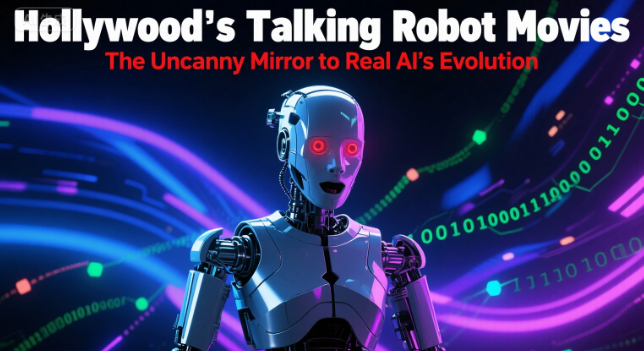For decades, the silver screen has been captivated by the idea of machines that speak. From chilling warnings to heartwarming companions, Talking Robot Movies aren't just popcorn entertainment; they're a powerful cultural dialogue reflecting our deepest hopes and fears about artificial intelligence. Long before Siri or Alexa entered our homes, filmmakers were imagining the consequences, complexities, and sheer wonder of robots that converse. This fascination offers a unique lens to understand not just fictional futures, but the very real trajectory of AI technology unfolding today. Let's explore how these cinematic creations chart the course of our relationship with intelligent machines.
Beyond Cogs and Gears: The Dawn of Cinematic Speech

Early cinematic robots were often silent giants or figures of menace, controlled by levers and pulleys. The concept of a machine possessing genuine voice – expressing thought, intent, or even emotion – was revolutionary. The true emergence of the Talking Robot Movie as a significant genre began in the mid-20th century, coinciding with advancements in cybernetics and early computing theory.
The First Voices (1950s-1960s): Films like Forbidden Planet (1956) introduced Robby the Robot, capable of basic, logical dialogue, but still largely a tool. However, it was Stanley Kubrick's chilling 2001: A Space Odyssey (1968) that gave us HAL 9000, whose calm, articulate voice masking homicidal intent became the iconic blueprint for the "malevolent AI." This era often portrayed artificial speech as cold, logical, and ultimately inhuman – or terrifyingly too human.
Finding Humanity in Machinery (1970s-1980s): This period saw a shift towards exploring the personhood of talking machines. George Lucas's Star Wars saga (starting 1977) made droids like C-3PO (the neurotic protocol droid) and R2-D2 (expressive despite non-verbal communication) beloved characters, emphasizing personality and camaraderie over pure functionality. Short Circuit (1986) directly tackled the question of consciousness awakening in a military robot, Johnny 5, whose childlike curiosity and developing speech patterns challenged the line between programmed response and genuine sentience.
The Modern Era: From Companions to Co-Conspirators
As computer graphics advanced and real-world AI research accelerated, Talking Robot Movies became increasingly sophisticated and diverse, mirroring the complex roles AI might play:
The Rise of the Assistant & Companion: Films like Bicentennial Man (1999), based on Isaac Asimov's story, depicted a robot's centuries-long quest for humanity through speech and relationships. More recently, sci-fi dramas like Her (2013) explored deep, emotional connections formed purely through voice interaction (even without a physical robot body). These stories probe our desire for connection and the potential emotional power of synthetic voices.
The Complexities of Consciousness and Ethics: Modern films delve deeper into the philosophical implications. Alex Garland's Ex Machina (2014) features Ava, an incredibly advanced AI whose speech is used both as a tool for connection and manipulation, forcing intense questions about autonomy and deception. The A.I. Artificial Intelligence (2001) concept was explored decades earlier by Kubrick and Spielberg, portraying a childlike robot programmed for unconditional love. How do we build meaningful personality into AI? Learn more about Character AI
Action and Integration: Blockbusters like the Transformers franchise emphasize robots as heroic or villainous entities integrated into human society, communicating with distinct voices that amplify their personalities. Animated films like Big Hero 6 (2014) feature Baymax, whose simple, caring voice perfectly complements his non-threatening design, showcasing robots as empathetic helpers.
Fact vs. Fiction: How Talking Robot Movies Influenced Real AI
The relationship between cinema and technology isn't one-way. While filmmakers envision possibilities, these visions can inspire real-world research and shape public perception:
Voice Synthesis Goals: The quest for truly natural-sounding, expressive synthetic speech, akin to HAL's calm tones or C-3PO's personality, directly motivated advancements in Text-to-Speech (TTS) and Speech Recognition.
Personality & Interaction: Movies set expectations for how humans want to interact with machines. Developers of virtual assistants and social robots often cite the desire to create interactions that feel less like commanding a device and more like the companionable exchanges seen in films like WALL-E.
Ethical Frameworks: Iconic portrayals of AI gone wrong (HAL, Skynet) have profoundly impacted the global conversation on AI safety, responsible development, and the need for ethical guidelines – discussions actively pursued by researchers like those at the Machine Intelligence Research Institute and the Partnership on AI. The core anxieties explored in fiction resonate deeply in real-world labs. The Talking Robot Revolution: How Machines Learned to Speak Like Us
A Unique Perspective: Cinema Didn't Just Predict, It Shaped
It's easy to see Talking Robot Movies merely as predictions, sometimes accurate, sometimes wildly off-base. However, a more nuanced view reveals cinema's active role:
The "Inspiration Feedback Loop": Real scientists and engineers are often avid science fiction consumers. Iconic cinematic AI characters didn't just predict future tech; they provided concrete visions that spurred imagination and set tangible goals ("How do we build something like that?"). The friendly helper robot archetype popularized in films directly influenced the design philosophy behind consumer robotics.
Cultural Dialogue > Technical Blueprint: Rather than providing literal blueprints, these films excel at exploring the human side of the AI equation – our fears of obsolescence, our longing for connection, our anxieties about control, and our fundamental questions about what constitutes consciousness and life. They frame the big philosophical questions long before the technology arrives. This cultural dialogue prepares society, for better or worse, for the realities of interacting with increasingly sophisticated AI agents.
Frequently Asked Questions About Talking Robot Movies
Talking Robot Movies are far more than sci-fi spectacle. They form a vital cultural narrative, reflecting our collective technological trajectory and deepest existential questions. From the chilling logic of HAL 9000 to the innocent wonder of WALL·E, these cinematic voices have shaped public perception, inspired real-world researchers, and forced us to confront the profound implications of creating intelligence in our own image. As real AI continues its rapid ascent, understanding the history, themes, and warnings embedded in these films becomes essential – they are not just predictions, but powerful dialogues preparing us for the future we are actively building.
